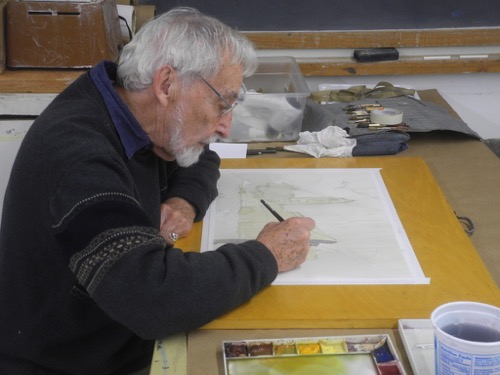"Can't Talk Without A Pencil"
WATERCOLOR SHOW BY LEO DODD
Show runs May 1 to May 31, 2018
Opening reception Friday, May 4th, 6-8pm
Geisel Gallery
The Geisel Gallery is located on the Second Floor (Mezzanine Level) of Legacy Tower
One Bausch & Lomb Place, Rochester, NY 14604
LEO DODD WATERCOLORS
220 of Leo Dodd's watercolors are posted here and arranged by topic.
Start at the BEGINNING and click photos to advance or jump to paintings on a particular topic by using the links below:
ADIRONDACKS
BAUSCH & LOMB CONSTRUCTION
BIRDWATCHERS
CAN OF WORMS CONSTRUCTION
CAPE COD
CHARLOTTE LIGHTHOUSE
DOWNTOWN ROCHESTER
EARLY TRANSPORTATION
FARMS
DOUGLAS ANTHONY BRIDGE
FRED LIPP PAINTING CLASS
GENESEE VALLEY PARK
IRONDEQUOIT
MAINE
MEMORIAL ART GALLERY
OAK HILL
OLD BRIGHTON
ORORKE/STUTSON STREET BRIDGE
ROCHESTER RED WINGS
VERMONT
MISCELLANEOUS
The Art of Leo Dodd
by Rick Muto, Muralist, Fine Artist, Axom Gallery Director
Leo Dodd made a career as a Kodak engineer, who had a lifelong interest in drawing and painting. Although his training was limited to only a few formal art classes in his college years at RIT, his life beyond was peppered with classes and workshops, which became more frequent after he retired.
Upon seeing his body of work from throughout the years one easily identifies him with the Regionalist movement of the early 20th century. Two artists that immediately come to mind are Thomas Hart Benton, one of the most respected leaders of the movement, and Carl Peters, a local landscape and mural artist, who taught at the U of R’s Memorial Art Gallery.
This can especially be seen in Dodd’s stylistic handling of his subjects which is most evident in the emphasis on gesture, gravity and movement, rather than exact proportion, perspective and detail in his subjects. This allowed him the freedom to express the underlying mood or energy of the subject.
Like Benton, Dodd’s work almost always included human activity.
What makes Leo Dodd’s work distinctive is the personal sensibility he brings to the subject. Some of the paintings are characteristic of the subject matter of the regionalist movement. They capture the culture of the region with faithfulness to the occupations and activities of the people that dwell in them. That could be as subtle as a plowed field, or as robustas a gathering in the middle of town.
But it was Dodd’s engineering background that brought a distinctive vision to his art, particularly in his choice of subject matter. He was drawn to construction sites where evidence of engineering feats was in plain view. His sensitivity to the physical properties of his subject matter is evident in the expressive drawing style in these works. This exhibit includes works depicting the construction of several bridges, the expressway intersection of Rochester’s Can of Worms, the construction of the Bausch Lomb Headquarters, and most recently, the installation of the limestone (Tom Otterness) figurative sculptures at the southeast entrance of the Memorial Art Gallery grounds.
Leo Dodd worked mostly on site, creating studies of his subjects in real time. It is this practice that allowed him to capture such movement in his subjects, and led him to avoid the obsession with detail. Some of the works in this show include images of the same subject rendered as a study, along with that same subject brought to a more “finished” resolve, perhaps in the studio. These multiple works of the same subject give the viewer insight into Dodd’s process of building his paintings.
Finally, what is most distinctive in Leo Dodd’s art is the composition and design, particularly in the activity filled construction scenes. In these works he has created images which have been distilled down to a lyrical interplay of geometric shapes and expressive color that reaches into the abstract vocabulary of the modernist period.
LEO DODD ARTIST'S TALK I-Square Gallery 2014
"3 D's in Dodd" show featured Leo Dodd, Paul Dodd and John Dodd. This video has been edited to feature Leo Dodd's portion.
Leo Dodd's Art Education History
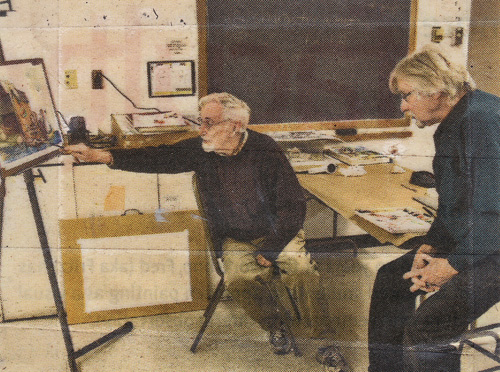
1956 Free-Hand Drawing at R.I.T., City of Rochester - Robert Brown
1957 Life Drawing at R.I.T., City of Rochester - Stanley Gordon
1958 Watercolor 1 - only 1 class at R.l.T., City of Rochester - Unknown instructor
1964‐65 Watercolor Studio at UR Memorial Art Gallery - Bernard Gertsner
1975 Silk Screen at B.O.C.E in Fairport, NY - Loretta Murawski
1985 Watercolor Workshop at Batavia, NY - John Hodgins
1986 Watercolor Workshop at Pine Acres, Arlington, Vermont - Frank Webb
1987 Bookmaking at Writers & Books, City of Rochester - Scott McCarney
1987 Watercolor Workshop at Old Forge, NY - Mario Cooper
1988 Watercolor Workshop at Greenville, NY - Zigmund Jankowski
1989, June,18‐25 Watercolor Workshop at Booth Bay Harbor, Maine - Carlton Plummer
1990, Sept. 23-28 Watercolor Workshop Pine Acres, Arlington, Vermont - Milford Zornes
1991 Watercolor Workshop at Pine Acres, Arlington, Vermont - Milford Zornes
1992 Watercolor Workshop at Green Mountain, California - Robert Wood
1994, July 20-28 Watercolor Workshop at Hewitt, San Diego, California - Dong Kingman
1994 Watercolor Workshop at Pine Acres, Arlington, Vermont - Milford Zornes
1995-2015 Advanced Painting Studio at UR Memorial Art Gallery - Fred (Fritz) Lipp
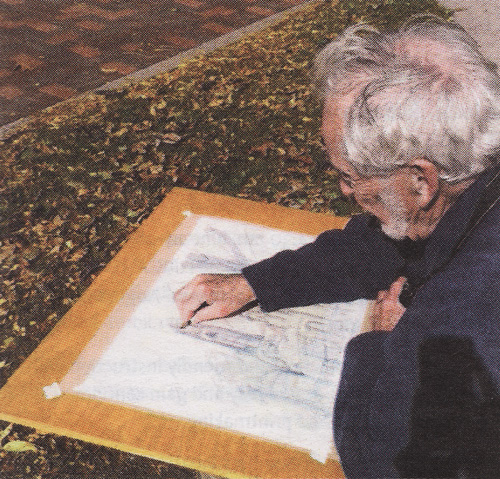
Articles
Brighton Artist Drawn by Can of Worms Project
By Derek Murphy - Brighton Pittsford Post 1991
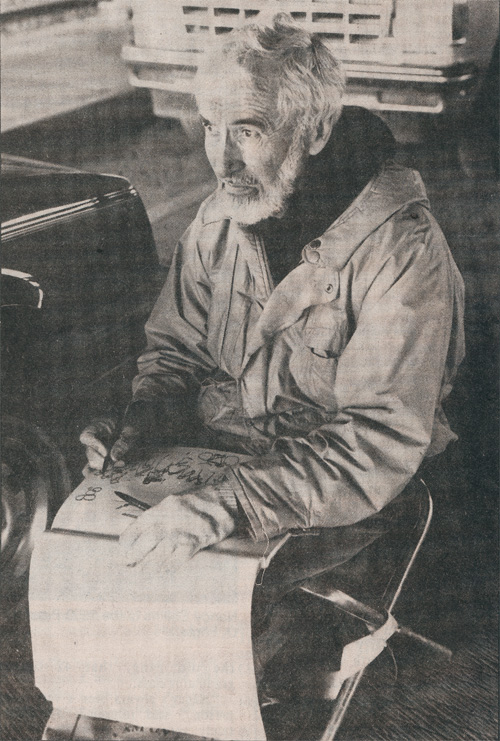
Leo Dodd is seen here drawing the East Avenue ribbon cutting.
Photo by John Wolfe
Kodak retiree has hundreds of sketches of $123 million reconstruction job
It might seem like a safe bet to call the Can of Worms reconstruction project a universal headache.
But for Leo Dodd of Brighton, that would be painting with too broad a brush.
"It was a dream come true," Dodd said last week, probably the only person in Monroe County who would say that with a straight face when it comes to the Can. But most people haven't spent the past two and a half years sketching the construction of the new $123 million interstate interchange. Dodd, 63, a retired Kodak engineer who has taught illustration courses at Rochester Institute of Technology, has made hundreds of small‐scale sketches of the Can reconstruction since work began in March of 1988.
They were done in ink, pencil, crayon, and watercolor, depending on the temperature and the artist's mood. Many are as small as a 3-by-5 card.
Dodd, who started sketching large‐scale construction projects four years ago, said the Can project was a blessing because it was just minutes from his home on Corwin Road.
"It was a great opportunity to watch something from beginning to end," he said. So while tens of thousands of people were dreading three years of detours, Dodd was delighted.
He said he was there with pen in hand, back when work began on the new Conrail bridge and blasting through the limestone bedrock that lines the construction site.
And he was there two weeks ago to draw the ribbon‐cutting ceremony for the reopening of East Avenue, closed since March, 1988. Brighton, county, and state officials were there to celebrate the opening. Some 300 merchants and residents were on hand, some dressed in costumes and all in a good mood.
"It was a chance to draw something a bit different," Dodd said. "There was quite an interesting collection."
The artist became a familiar sight to the Can engineers and crew, perched on his stool at the edge of the construction site. He was there at least one day a week for about four to five hours, he said, and edged nearer and nearer to the workers each time he visited. "They were very nice," Dodd said. "The thing that worried me was, was I in the way?"
One engineer told him that he wanted to write an article about the project, and asked if Dodd would agree to illustrate it. The article was submitted to a local newspaper, but never appeared. Another engineer told Dodd he is keeping a diary about the project.
As engineer and artist, Dodd said he finds the Can reconstruction intriguing "because of the scale of the people to the job." Fewer than a dozen men worked the huge machines that swung 10-ton bridge beams into place, Dodd said. He said he considered that an example of how technology has changed the world.
"The whole time, I saw maybe one guy with a shovel in his hand," he said.
The motion of the steel as it was maneuvered into place, the pouring of the concrete, and the constant activity of the work crews fascinated Dodd. It is the essence of his drawings, an essence that he said couldn't have been captured on film.
"You have to really be at a scene to record it," he said, "Photos don't get the same feel. I can't draw it unless I observe it."
Dodd said he has been drawing throughout his life, but couldn't do it full time until he retired from Kodak's government systems division in 1986. Dodd's engineering eye is abetted by watercolor courses at RIT, where he eventually taught watercolor courses for a semester after he left Kodak.
At that time, construction was beginning on the new Memorial Bridge on Driving Park Avenue over the Genesee River gorge in the city. That was Dodd's first project.
"That was an interesting span, and being an engineer, I like observing the construction." Some of the workers from that project worked on the Can as well, and recognized him, he said.
In between, Dodd sketched farm scenes, the Lake Ontario shoreline, and downtown Rochester. Then in 1988, the state Department of Transportation and the Can of Worms general contractor, Perini Corp., closed off East Avenue and began tearing down the old Can of Worms.
Dodd said he plans to transfer his smaller sketches of the Can reconstruction to full 22-by-30-inch watercolor sheets and put together a pictorial history of the project, which was the largest single contract job in the history of the state.
The opening of East Avenue puts the bulk of the Can project in the past and ends the current construction season. But nearly $10 million in work remains when crews return in the Spring. Dodd said he will be right there with them.
"It'll probably go on for quite a while," he said.
Brighton Artist Drawn to Can Project
By Annette Stoner - Rochester Democrat & Chronicle
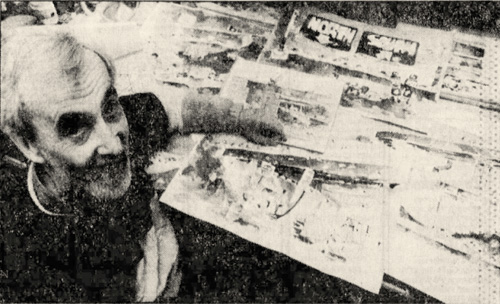
BRIGHTON ‐ Leo Dodd doesn't go very far without his pen and sketch pad.
He takes the tools of his hobby with him when he and Mary, his wife of 41 years, go on bus trips, when they travel greater distances to places like England and Cape Cod, or when they are out for an evening listening to the Rochester Philharmonic Orchestra.
When Dodd retired as an engineer from Eastman Kodak Co. in 1986 and had some extra time on his hands, he decided to pursue a love he's had all his life: sketching. Since then, he's traveled around Rochester sketching many local sights and sounds. He has driven to Lake Ontario and spent the better part of the day drawing scenes there. He has gone to area parks and drawn. So it was only natural that Dodd, a technical and mechanical engineer for 36 years, wanted to sketch something close to home ‐ his home on Corwin Road ‐ the Can of Worms.
Since construction started on the Can of Worms reconstruction project in 1988. Dodd has been out there ‐ during the day and at night, in cold or warm weather ‐ watching the crews' every move. He has about 1,000 sketches and 10 paintings to prove it.
His den‐turned-drawing room is filled with volume after volume of sketch books, all carefully lined up on a shelf ‐ all tagged with the date and subject matter on white bookmarks.
Dodd. a soft-spoken. gray‐ haired man, never was formally trained as a painter. But sketching is in his blood. As he said, "I've always drawn. He drew cartoons for his college newspaper. The Villanovan, at Villanova University.
His engineering job allowed him to show his ideas in technical sketches. Most times, though, he was confined to an81/2-by-ll-inch piece of paper. "I was trained to express something in a small area," explained Dodd, as he thumbed through some of his sketches. "When I retired. I continued that."
Many of his sketches are miniatures of construction workers, bridges and large machines, including a dump truck. "It's just fun to sketch equipment," said Dodd, with a smile. "I guess it's the engineer in me." He sketched everything he saw, from the green signs on interstates 490 and 590, to the vehicles that were whizzing by him. How close he got to the work depended on what was being worked on, he said.
"When roads were worked on, sometimes I was right up against them," he said. But if the crews were on the move, or were working with steel beams and the like, he kept his distance. "I was expecting to be told to leave," remembered Dodd. "But I wasn't."
So about three times a week, he'd set up his camping stool by I‐ 490 near East Avenue or closer to the I-490 and I-590 split, grab a pencil, pen, colored pencil or his watercolor paints and get to work. "These people worked," said Dodd. "They worked hard all day. '
He said the workers didn't have much time to take notice of what he was doing, but some managed a 'smile, a wave or a hello on their way to pick up another beam or to go to their truck.
"At the Can it was constantly a bustle of activity. It was hard to concentrate on defining a composition," said Dodd. "It was changing every minute." "The fun of the Can was just that ‐ imposed activity with something changing all the time." He would spend several hours sketching during each outing ‐ even when the temperatures dropped. "It was cold a lot of days, but you draw with gloves on and fast. "Dodd said, his eyes sparkling.
Dodd and his wife both grew up in Rochester ‐ he in the 19th ward and Mary in the 21st. They lived in the city after they were married in June 1949. They moved to Webster when their seven children were growing up. In 1975. they moved to Brighton. They now have seven grandchildren. Pictures of the grandchildren decorate several tables in his home, while many of the walls display Dodd's artwork.
"I'm retired. It is my time. I always wanted to sketch and draw. It's fun to pack up in the morning and go off to sketch and draw," said Dodd. "The whole process of drawing is fun." "After being inside for 36 years, outside sketching is fun."
He used his experience in the fall of 1987 and taught a sketching class at Rochester Institute of Technology. The students had to do what he was doing; sketching what they saw in their neighborhoods. After the Can of Worms project started, he spent many hours tracking its progress.
Only a few vacations and a yearlong job at the University of Rochester's laser lab ‐ doing sketches for a proposed expansion ‐ slowed him down. But the Can of Worms project was to Dodd "a good exercise in finding out how to draw."
Dodd plans to go back out to the Can when work gets started again in March. But he may have some conflicts. March is the time he normally takes jaunts to Ellison Park to spot the skunk cabbage, a green and purplish flower. "You wait all winter for spring to start and the skunk cabbages are the first signs of spring," said Dodd, as he pulled out some sketches of the flowers. With a laugh, he said: "l'll be torn between the skunks and the Can when I start out again."
